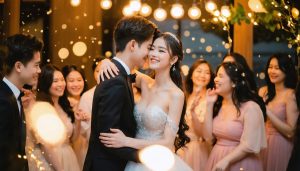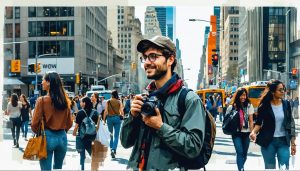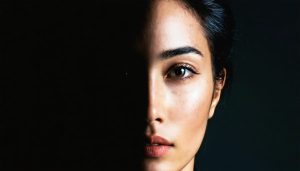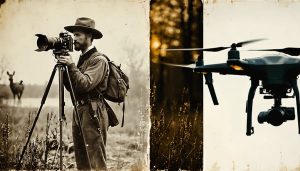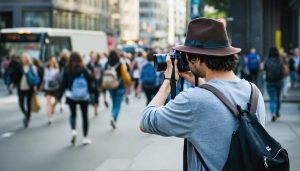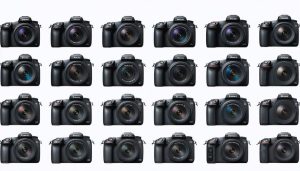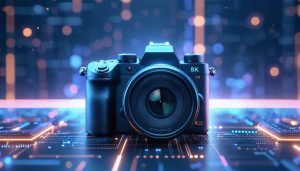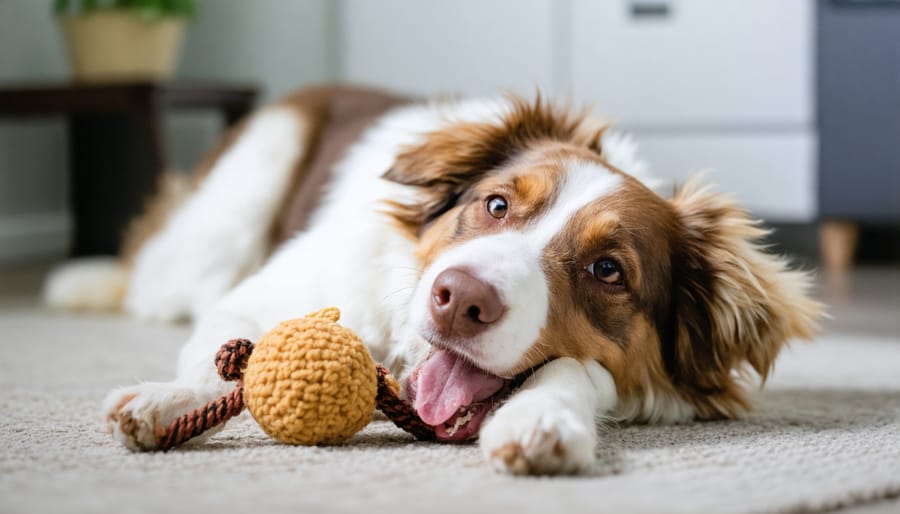
In the heart of every compelling photograph lies a story waiting to be told – not just through pixels and light, but through the indefinable spark that makes a subject uniquely itself. Capturing essence transcends technical perfection; it’s about freezing those fleeting moments when personality, emotion, and authenticity align through your viewfinder.
Think of essence as the visual poetry of what makes something distinctly real – the mischievous glint in a dog’s eye just before they pounce on their favorite toy, the tender way a mother cat grooms her kittens, or the proud stance of a horse in morning light. It’s found in the spaces between posed shots, in the natural behaviors and unconscious expressions that reveal true character.
The art of capturing essence requires equal parts technical skill and emotional intelligence. It demands patience to observe, instinct to anticipate, and the ability to recognize those split-second opportunities when a subject’s true nature shines through. This isn’t about perfect lighting or flawless composition – though these matter – but about creating images that make viewers feel something genuine and profound.
For photographers, mastering this skill means learning to see beyond the surface, to understand that our greatest tools aren’t our cameras, but our ability to connect, observe, and wait for those magical moments when authenticity presents itself naturally.
Understanding Your Subject’s Character
Reading Pet Body Language
Understanding your pet’s body language is crucial for capturing authentic moments in photography. A wagging tail doesn’t always mean happiness – observe the whole body for a complete picture. For dogs, relaxed ears and a soft mouth indicate contentment, while raised hackles or whale eyes (showing whites of the eyes) suggest discomfort. With cats, a straight-up tail usually signals confidence and friendliness, while a twitching tail tip often indicates rising excitement or agitation.
Watch for subtle cues like ear position and whisker placement. Forward-facing whiskers and ears typically show interest or alertness – perfect for engaging portraits. Flattened ears or backward-facing whiskers might mean it’s time to give your pet space.
Pay attention to your pet’s typical behavior patterns throughout the day. Many animals are most expressive during their active periods, like early morning or evening. Learn to recognize when they’re in a playful mood versus when they’re feeling mellow, and adjust your photography approach accordingly.
Remember, forced poses rarely capture true personality. Instead, watch for natural behaviors and be ready to capture those genuine moments when they occur.
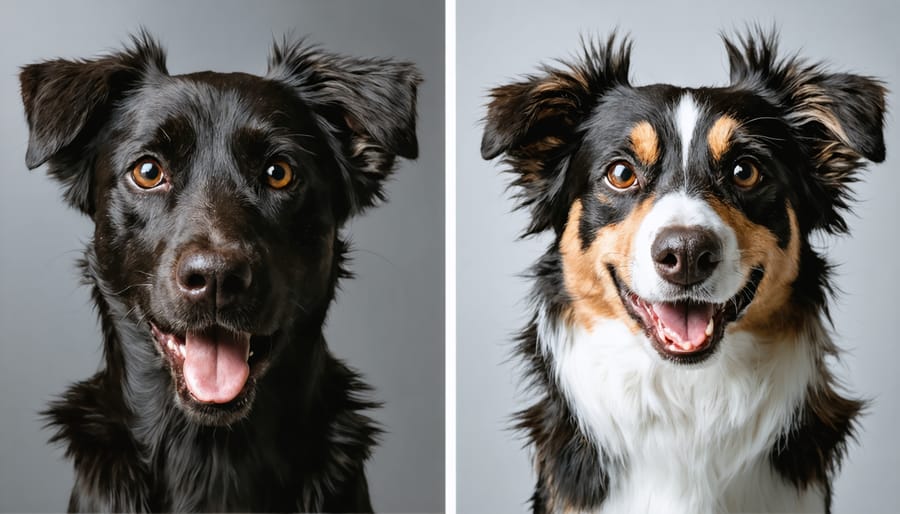
Creating a Comfortable Environment
The key to capturing authentic pet moments lies in creating the right atmosphere where your furry subject feels completely at ease. Start by choosing a familiar location where your pet naturally spends time, whether it’s their favorite sunbathing spot or their preferred play area. Remove any potentially distracting or unfamiliar objects that might make them nervous.
Consider the lighting carefully – natural light from windows often works best as artificial lighting equipment can be intimidating to pets. If you’re shooting indoors, open curtains and position your pet where soft, diffused light falls naturally. Keep the room at a comfortable temperature and maintain their regular routine as much as possible.
Have their favorite toys and treats readily available, but don’t overwhelm them with too many options. Keep noise levels low and movements gentle. If your pet has a preferred time of day when they’re most active or relaxed, plan your session around these natural rhythms. Remember, a comfortable pet will display their true personality, resulting in more authentic and emotionally resonant photographs.
Technical Aspects That Matter
Fast Shutter Speed Techniques
Mastering fast shutter speeds is crucial when you need to capture quick movements and fleeting expressions that make your photos truly memorable. Start by setting your camera to shutter priority mode (Tv or S) and experiment with speeds of 1/500th of a second or faster for most active situations.
For indoor shoots, you’ll want to compensate for the faster shutter speed by either increasing your ISO (typically 800-1600) or using additional lighting. This helps maintain proper exposure while freezing motion. When shooting outdoors in daylight, you can typically use lower ISO values while maintaining those quick shutter speeds.
A helpful technique is to pre-focus on an area where you anticipate action will occur. This works particularly well when photographing playful pets or children at play. Use continuous autofocus (AI Servo for Canon, AF-C for Nikon) to track moving subjects effectively.
Remember that different scenarios require different speeds: 1/500th works well for walking or casual movement, while 1/1000th or faster is better for running or jumping shots. For especially fast action, like capturing water droplets or sports movements, consider speeds of 1/2000th or higher.
The key is practice and anticipation – learn to predict moments of peak action and be ready with your finger on the shutter. This combination of technical settings and timing awareness will help you catch those split-second moments that tell the story.
Focus and Composition Strategies
Creating captivating pet portraits starts with mastering two fundamental elements: precise focus and thoughtful composition. When it comes to focus, the eyes are your primary target – they’re the windows to your pet’s soul and should be tack-sharp in your images. To achieve perfect focus techniques, switch to single-point autofocus and position your focus point directly on the eye closest to the camera.
For optimal sharpness, maintain an aperture between f/2.8 and f/4 to create that beautiful background blur while keeping the essential features crisp. Remember that when shooting at eye level, you’ll want to ensure there’s enough depth of field to keep both eyes in focus, especially if your subject is facing you at an angle.
Composition-wise, the rule of thirds remains a reliable starting point, but don’t be afraid to break it intentionally. Position your pet’s eyes along the upper third line of your frame to create a natural, engaging perspective. Leave space in the direction your subject is looking or moving to create a sense of movement and story within the frame.
Consider your background carefully – a cluttered environment can detract from your subject’s presence. Look for clean, simple backgrounds that complement rather than compete with your pet. Natural frames like doorways, arches, or foliage can add depth and direct attention to your subject.
For more dynamic shots, experiment with different angles. Get down to your pet’s eye level for an intimate perspective, or shoot from slightly above for a more commanding presence. Pay attention to leading lines in your environment – they can naturally guide the viewer’s eye toward your subject.
Remember that negative space can be just as powerful as your subject itself. Don’t feel compelled to fill the entire frame; sometimes, giving your pet room to “breathe” in the composition can create a more impactful image that truly captures their essence.
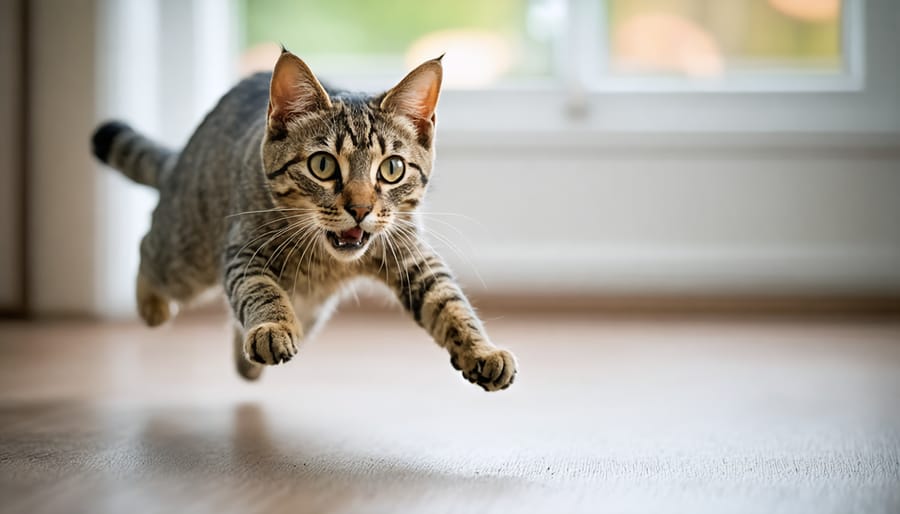
Timing and Patience
Anticipating Key Moments
The key to capturing authentic moments lies in your ability to anticipate them before they happen. This skill, while seemingly magical, is actually a combination of observation, preparation, and understanding your subject’s behavior patterns.
Start by spending time observing your subject without your camera. Notice the subtle signs that precede important moments – a dog’s ears perking up before they jump, a cat’s tail twitching before pouncing, or a bird’s slight head tilt before taking flight. These micro-expressions and body language cues are your roadmap to capturing genuine moments.
Position yourself strategically based on these observations. If you know your cat always stretches in the morning sunlight, set up your shot beforehand. For dogs, understand their play patterns – many will return to the same spot during fetch or follow predictable paths during their excitement bursts.
Timing is everything, so keep your camera settings ready. Use continuous focus mode for active subjects and burst mode for fast-moving action. Pre-focus on areas where you expect the action to occur, especially in predictable situations like feeding time or familiar play scenarios.
Remember that anticipation isn’t just about technical preparation – it’s about emotional readiness too. Stay present and engaged with your subject, as animals can sense when you’re distracted. The more you practice this mindful observation, the more natural your timing will become, leading to those perfect shots that truly capture the essence of the moment.
Working With Different Pet Personalities
Every pet has a unique personality, and successful pet photography requires adapting your approach accordingly. When working with shy pets, patience is your greatest ally. Start by giving them space and letting them get comfortable with your presence and equipment. Keep movements slow and deliberate, and consider using a longer lens to maintain distance while capturing intimate moments.
For energetic pets, embrace their playful nature rather than fighting it. Fast shutter speeds (1/500 or faster) are essential to freeze action, and burst mode can help capture those split-second expressions. Consider incorporating their favorite toys or activities into the shoot, but be ready to move quickly and adjust your position as they dart around.
Stubborn pets present a different challenge. Rather than forcing them into poses, work with their natural tendencies. If they prefer certain spots or positions, use these as starting points. Treats can be helpful, but avoid overusing them as this might lead to forced expressions. Sometimes, the most authentic shots come from simply following their lead and waiting for natural moments.
Remember that timing is everything, regardless of personality type. Watch for subtle cues in their behavior – the slight tilt of a head, a perked ear, or a moment of curiosity. These fleeting instances often reveal the true character of your subject and make for the most compelling photographs.
Post-Processing for Personality
Enhancing Eyes and Expressions
The eyes are often called the windows to the soul, and this holds especially true in pet photography. When editing your pet portraits, subtle adjustments to the eyes can dramatically impact how personality shines through in your images. Start by making minor clarity and exposure adjustments to bring out the eye’s natural detail, being careful not to overdo it and create an artificial look.
To enhance natural expressions, focus on bringing out the catchlights – those small reflections that make eyes appear alive and engaging. A slight boost in exposure and contrast specifically in the eye area can make these catchlights pop without affecting the rest of the image.
Pay special attention to the surrounding fur and facial features that contribute to your pet’s expressions. Small adjustments to shadows and highlights around the eyes, muzzle, and ears can emphasize their natural character. Use selective brushing to gently brighten the area around the eyes, creating depth and drawing attention to their gaze.
Remember that less is more when editing expressions. Your goal is to enhance what’s already there, not create something artificial. Keep adjustments subtle and natural-looking, preserving the authentic personality that made you want to capture the image in the first place. A light touch with clarity and selective sharpening can bring out fur texture and facial details without making the image look overly processed.
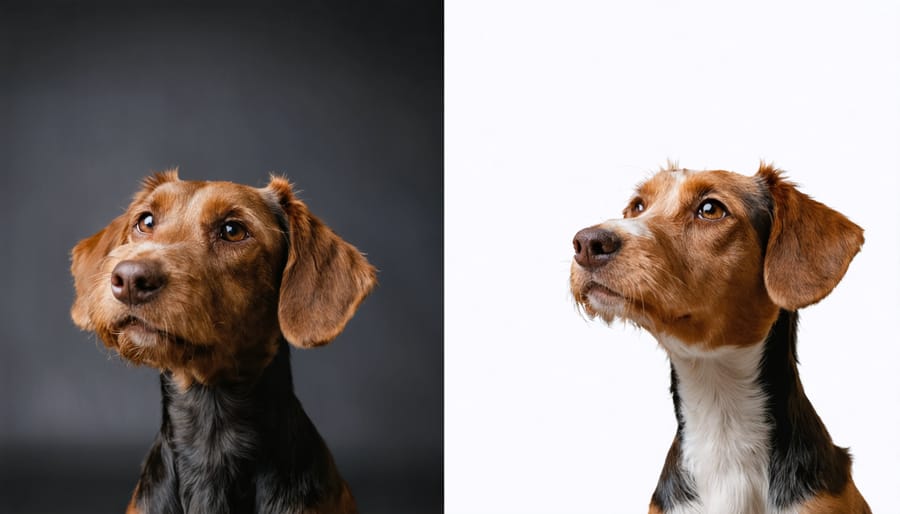
Maintaining Natural Look
In the pursuit of capturing authentic moments, it’s crucial to resist the temptation of over-processing your images. Start by getting things right in camera – proper exposure and white balance will minimize the need for heavy post-processing. When editing, maintain a light touch and focus on enhancing rather than transforming the image.
A common pitfall is excessive saturation and contrast adjustment. While these tools can add punch to your images, they can quickly make photos look artificial. Instead, make subtle adjustments that preserve the natural qualities of light and color. Pay particular attention to skin tones and natural textures, as these are often the first elements to look unnatural with heavy processing.
Consider working in layers when editing, stepping away periodically to view your work with fresh eyes. A good practice is to compare your edited version with the original throughout the process. If the difference is dramatic, you might want to dial back some adjustments.
Remember that authenticity often lies in the imperfections. Not every shadow needs to be lifted, and not every highlight needs to be recovered. Sometimes, the natural play of light and shadow adds depth and character to your image. Focus on enhancing the mood and emotion while maintaining the integrity of the original scene.
The goal is to present a refined version of reality, not create an entirely new one. When viewers look at your photos, they should feel the authenticity of the moment rather than notice the processing.
Capturing the essence of your subject is both an art and a skill that develops with time and practice. Throughout this guide, we’ve explored the fundamental techniques that help create images that speak to the viewer’s heart – from understanding your subject’s unique personality to mastering the technical aspects of your camera.
Remember that truly memorable photographs go beyond mere documentation. They tell stories, evoke emotions, and capture fleeting moments that might otherwise be lost to time. Whether you’re photographing pets, people, or places, the principles we’ve discussed remain constant: patience, observation, and genuine connection with your subject are your greatest tools.
Don’t be discouraged if your first attempts don’t match your vision. Like any creative pursuit, capturing essence requires practice and persistence. Start by implementing one technique at a time, perhaps focusing first on anticipating moments or working on creating comfortable environments for your subjects. As these skills become second nature, layer in additional techniques until they form a seamless part of your photographic approach.
Keep experimenting with different angles, lighting conditions, and environments. Each session is an opportunity to learn and grow. Most importantly, maintain your enthusiasm and genuine interest in your subjects – this authentic connection will always shine through in your final images.
The true joy of essence photography lies not just in the final image, but in the journey of discovery and connection it creates between photographer and subject.


